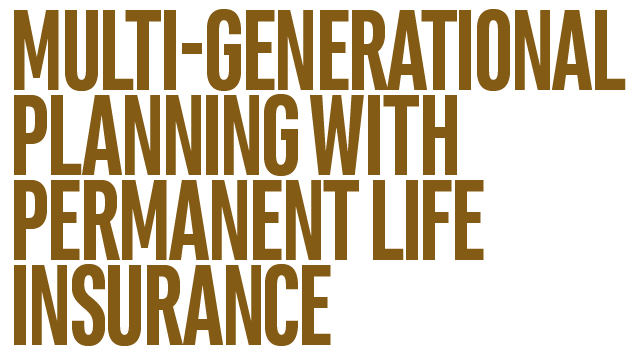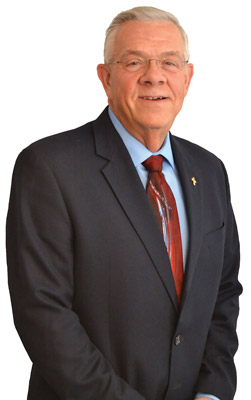
Move beyond 401(k) and IRA Savings
By Thomas Young
My primary focus with clients and prospects is to find out why they come to see me. If we can determine why they want to strategize for the future, we can get to the root of their financial challenges and potential solutions. With such an overload of financial information, misinformation and inappropriate financial noise, their reasoning can provide valuable insight into their levels of financial literacy. Without a “why,” we’re just high-pressure salespeople with no clear direction and understanding of clients’ needs. Often, the most significant financial challenge clients possess is a lack of adequate savings and capital for the future. The status of their personal savings and the evaluation of national debt can guide our strategic conversations and product recommendations. To store money for emergencies, emotional purchases and long-term savings, I recommend life insurance as a capital warehouse and a tool for multi-generational planning.
Frame the Conversation
After listening to my prospects talk about what motivated them to meet with me and what they hope to accomplish, I begin client meetings with conversations about the U.S. debt clock, a real-time resource which shows the movement of money inside the federal government. Without biases or opinions, the clock simply conveys the numbers as they are. We first look at the national debt levels. Currently, the U.S. is in over $22 trillion of debt, increasing every second. Then, we look at the unfunded liability by the federal government, which includes the Social Security program, Medicare Parts A, B and D and pension plans for government and military employees. These are strong commitments made to citizens; yet, these programs carry an unfunded liability of $122 trillion, which is over $1 million dollars per taxpayer. With this in mind, I make sure my clients know that taxes will be higher in the future to fund this deficit and will affect their future savings capabilities.
Move Beyond 401(k) or IRA Savings Vehicles
In typical planning situations, people are often told to max out a 401(k) or IRA as primary savings tools. However, these vehicles postpone the tax on the money, and also the calculation of the tax. Now that my clients understand the inevitability of higher tax rates, we seek other ways to create wealth and capital for the future.
Dividend-paying mutual whole life insurance is the safest place to store money, so much so that even the Federal Reserve has indicated to its member banks that life insurance has the least risk default. On average 20 to 30% of all Tier 1 money in banks is stored in permanent guaranteed whole life insurance. Yet, consumers are often told not to buy permanent life insurance. If we can prove the value of this policy, we can help clients secure proper savings for their retirement and established legacies to pass on to their families.

Multi-Generational Planning Considerations
Increased longevity and higher tax rates have changed the way we need to help future generations plan as they will need more and more capital to survive. Multi-generational life insurance strategies, which involve insuring anyone who is insurable, allows clients to set their family up for a secure financial future. Whole Life sales are approaching 35 percent in the marketplace due to the invaluable guarantees. Guaranteed cash value, death benefit, premiums and non-forfeiture provisions are capabilities that appeal to multiple generations and can lead to an established financial legacy to pass down.
For instance, I own policies on my daughter and son-in-law. My goal is to live long enough to watch my two grandsons become adults so that I can teach them how to continue the savings process and transfer the ownership of these policies to them. My daughter also owns a life insurance policy on me, which is her pension plan. When I pass away, she will receive the death benefit of that policy absolutely tax free. The tax-free check she receives if I live to the average male life expectancy is something she can’t match with an IRA or 401(k) at an equal contribution amount.
Between now and then, the policy also has a tremendous amount of cash value. We borrow from the insurance company against that cash value to buy cars and avoid credit cards so we don’t have any credit at the banks. The average household in the U.S. has $250,000 of debt and pays 34 cents out of every dollar they earn on interest at the bank. If you can set up a family with a policy that has cash value, imagine the wealth you could create if the plan mitigates debt payments for the rest of their lives. Their beneficiaries would have an unbelievable amount of money set aside for retirement. If you change the way you think about products that have been in existence for over 200 years in America, you can help clients learn the discipline and immense advantages of savings.
Importance of Savings and Living Benefits
If our clients fall into the category with the majority of Americans whose average rate of savings is around 3%, we must help them understand this will not provide the much-needed stability during retirement. Sometime in the future, the government debt will catch up with citizens and cause a huge financial storm. Even though the debt threat will continue to loom, we can help clients strategically set aside efficient savings to be protected. While most clients want to fulfill their financial goals with investments, we should emphasize the need to first establish savings.
Life insurance is a product that people both need and want, which enables clients to secure and grow savings. The living benefits of cash value permanent life insurance, such as tax-free access to cash value and tax-deferred growth, leads to increased savings capabilities for clients. It is also guaranteed to pay the policy owner regardless of when the covered individual passes, and the policy holder has access to recapture assets and avoid debt through the guaranteed cash flow. All of these benefits are possible with no additional out-of-pocket costs. While there is a limit to prevent over insurance, why would clients not want to purchase this policy? Help them understand how to funnel money they are already spending through their policies to establish an effective financial plan and achieve their goals.
Fiduciary Responsibility
Over the past few years, the financial industry fought hard when the government wanted to impose a fiduciary responsibility on advisors. However, nobody should have to impose that on you, because it should be automatic. Fiduciary simply means we should be doing the best and the right thing for our clients through proper education and plan options. Client education is a vital responsibility for advisors. I maintain a blog and website to help drive home the importance of life insurance and its multi-generational strategies capabilities.
We cannot predict which generation will face the financial storm head on in the future. We can help prepare our clients so that when someone in their family passes, their economic human value is inherited by the next generation to store once again in cash value life insurance. If you are in this business to help people, you are in the right place. On the other hand, if you are solely in the industry to make a commission, you ought to consider a new occupation. We are the only people in the world who can create the money to care for the future. Be authentic with your client services and purposeful with your product recommendations to ensure you have a positive effect on generations of consumers to come.

Tom Young started in the financial services industry in 1976, and is the founder and president of 1st Consultants, Inc. Tom is a financial strategist who uses time value concepts and lost opportunity cost evaluations to help clients maximize the time value of money and benefits associated with insurance and financial products. Tom is a professional speaker, a published author, and a radio personality on 1230/1460 WBVP/WMBA in Beaver Falls, PA. Tom is a 27-year member of the prestigious MDRT and has earned Court of the Table and Top of the Table qualifications.
